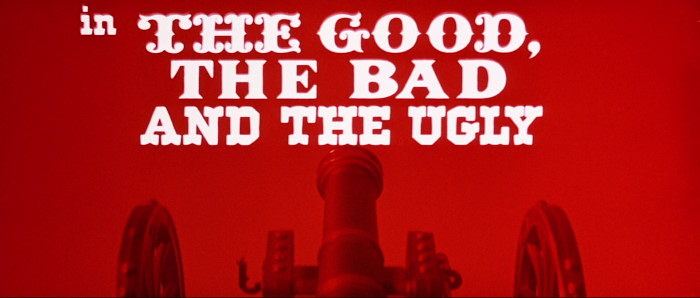
Okay, I lied. This truly is the best of the trilogy. With each film, Leone expands in all the right ways. For one, the budget goes up considerably, as does the polish and production value; but more than that, the characters multiply and deepen, the world gets bigger, the plot more complicated (in an interesting way), and the themes become more nuanced. By the time we get to this, the most famous of the three, everything seems to be working together, a perfect storm of a film. The damn thing is three solid hours long, and although it feels it, you're never bored at all.
In fact, the three hours seem almost perfectly broken into equal-sized acts. The first hour is spent building the three characters, particularly the relationship between Blondie (the Good) and Tuco (the Ugly), with the ever-looming spectre of Angel Eyes (the Bad) homing in slowly on a load of money. At the one-hour mark, Blondie and Tuco stumble upon Bill Carson and each learn half the information needed to find the treasure. Act Two is spent bumbling through a mission, the confederates, the yankees, and eventually teaming up with Angel Eyes and his gang. At the two-hour mark, the showdown in the ghost town equalizes the three and sets them up for the final chase to the cemetery. Act Three is spent crossing the final thresholds and squaring off one-on-one-on-one in a fascinating if awfully convenient standoff to end all standoffs.
It's such a film about sides and shifting loyalties! You've got a constant backdrop of the end of the civil war, and the characters bounce between both sides, impersonating with little difficulty whichever side is likely to help their cause. Then you've got Blondie and Angel Eyes, explicitly demarcated for us as "Good" and "Bad" respectively, even though both are fairly underhanded throughout (but it's never ambiguous: Blondie is definitely the compassionate one, Angel Eyes the ice-cold murderer), and this obviously leaves Tuco, our Ugly, as the wildcard, the middle, the shifter. Tuco bounces easily between being as backstabbing and devious as Angel Eyes or as warm and amiable as Blondie (which, for this world, is remarkably warm and amiable, actually), and this has a double effect. First, it makes him the key to the whole story, because shifting allegiances and constantly choosing sides is what the story hinges on in so many ways. It also makes him the most interesting to watch, as he is the most dynamic, unpredictable character of the three. (Eli Wallach is really the star here, if you ask me, stealing every scene he's in.)
The climax of the film hinges on the fact that Tuco has more or less sided with Blondie throughout, that he was never really as bad as Bad, he never really allied with Angel Eyes after all, and since it was a pull for power between two (not three) sides, since this was a tug-of-war between Good and Bad, having Ugly side with Good tipped the scales. In a film all about shifting allegiances, it has to all come down to who the wildcard sides with.
The story deals so well with the absurdity of right and wrong, the brutal pointlessness of war, the fundamental lack of difference between "good" and "evil" as opposing forces, and the soul-wearying effect war has on a culture, not to mention comments on class, desperation, friendship, religion, family, and community as well. It's so rich. Too layered for me to do it justice here, that's for sure. I've heard somewhere or other that Leone's masterpiece is supposed to be Once Upon a Time in the West, but it's hard to imagine a film better than The Good, the Bad and the Ugly for revisionist 60s westerns (spaghetti or no). Then again, I said something similar about For A Few Dollars More pretty recently, so.
Only one way to find out.

No comments:
Post a Comment